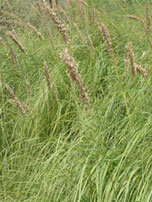Kusha

Botanical Name : Desmostachya bipinnata Stapf.
Family : Gramineae; Poaceae
Introduction :
Latin name: Desmostachya – desmo = woolly. stachyus = spiked; bipinnata – bi= two, pinnata = having feathers.
Names in different Indian languages :
English : Sacrificial Grass
Hindi : Dab, davoli
Kannada : Darbha
Malayalam : Darbha, darbhappullu
Sanskrit : Kusha, darbha
Tamil : Tharubai, darbhaipul
Telugu : Dharbha, kusa dharbha
Synonyms :
Kusha, Suuchyagra, Yagyabhuushana, Brahmapavitra, Tikshna, Kshurapatra, raja darbha
Eragrostis cynosuroides Beauv.
Morphology :
A shrub 2.5 cms. to 2.5 mirs. high with a long lifespan.
Roots – deep and strong.
Leaves – arise from the root having length 1 mtrs and width 2 mtrs.
They are pointed at the tip with tiny and string thorns on both the edges. flower stalk – 15 cm. to 45 cm. long and straight.
Seeds – 0.75 cm. long, ovoid and flat, flowering in monsoon and fruits come in winter. Darbha belongs to the same variety. It has long and rough leaves.
Distribution & Habitat :
All over India
Properties :
Guna : laghu, snigdha;
Rasa : madhur. kashaya;
Vipaka : madhur;
Virya : sheeta;
Dosha pittakaphaghna.
Karma :
Tridoshaghnam, sukla rakta shudikaram
cooling, diuretic, galactagogue, astringent
Indication :
urinary calculi, menorrhagia, dysentery, diarrhea, skin diseases
Part used :
Root
Dosage :
Powder 2-4 g
Decoction 50-100 ml
Internal uses :
As it is haemostatic, it is used in diarrhoea and dysentery with bleeding per rectum. menorrhagia and other bleeding disorders. It is a galactogoque. It has diuretic and lithotripsic properties. hence it is used in dysuria and calculi. Its decoction is helpful in skin disorders.
Important Yogas or Formations :
Trinapanchamool kwath, Kushavaleha. Kushadya ghrit.